Page 312 of 424
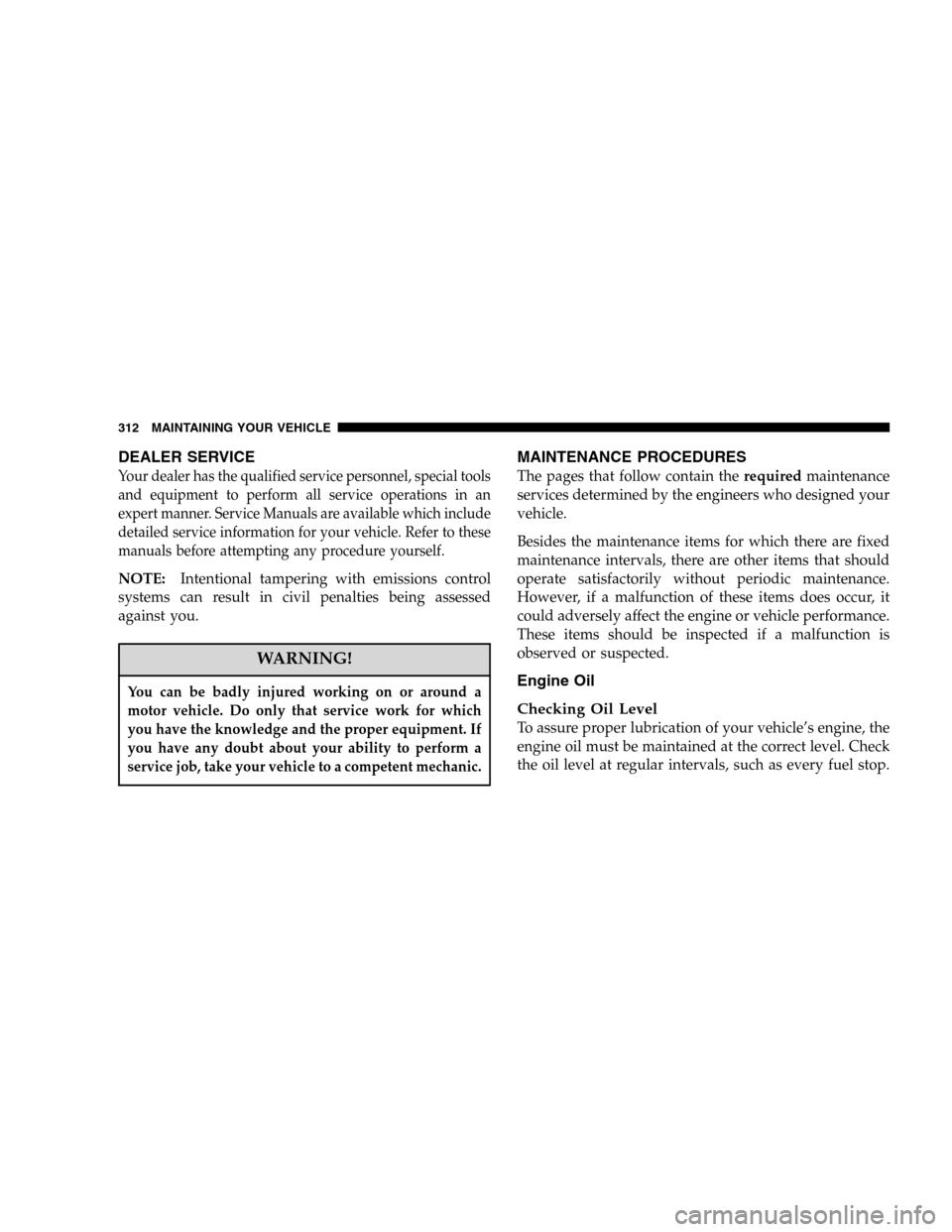
DEALER SERVICE
Your dealer has the qualified service personnel, special tools
and equipment to perform all service operations in an
expert manner. Service Manuals are available which include
detailed service information for your vehicle. Refer to these
manuals before attempting any procedure yourself.
NOTE:Intentional tampering with emissions control
systems can result in civil penalties being assessed
against you.
WARNING!
You can be badly injured working on or around a
motor vehicle. Do only that service work for which
you have the knowledge and the proper equipment. If
you have any doubt about your ability to perform a
service job, take your vehicle to a competent mechanic.
MAINTENANCE PROCEDURES
The pages that follow contain therequiredmaintenance
services determined by the engineers who designed your
vehicle.
Besides the maintenance items for which there are fixed
maintenance intervals, there are other items that should
operate satisfactorily without periodic maintenance.
However, if a malfunction of these items does occur, it
could adversely affect the engine or vehicle performance.
These items should be inspected if a malfunction is
observed or suspected.
Engine Oil
Checking Oil Level
To assure proper lubrication of your vehicle’s engine, the
engine oil must be maintained at the correct level. Check
the oil level at regular intervals, such as every fuel stop.
312 MAINTAINING YOUR VEHICLE
Page 313 of 424
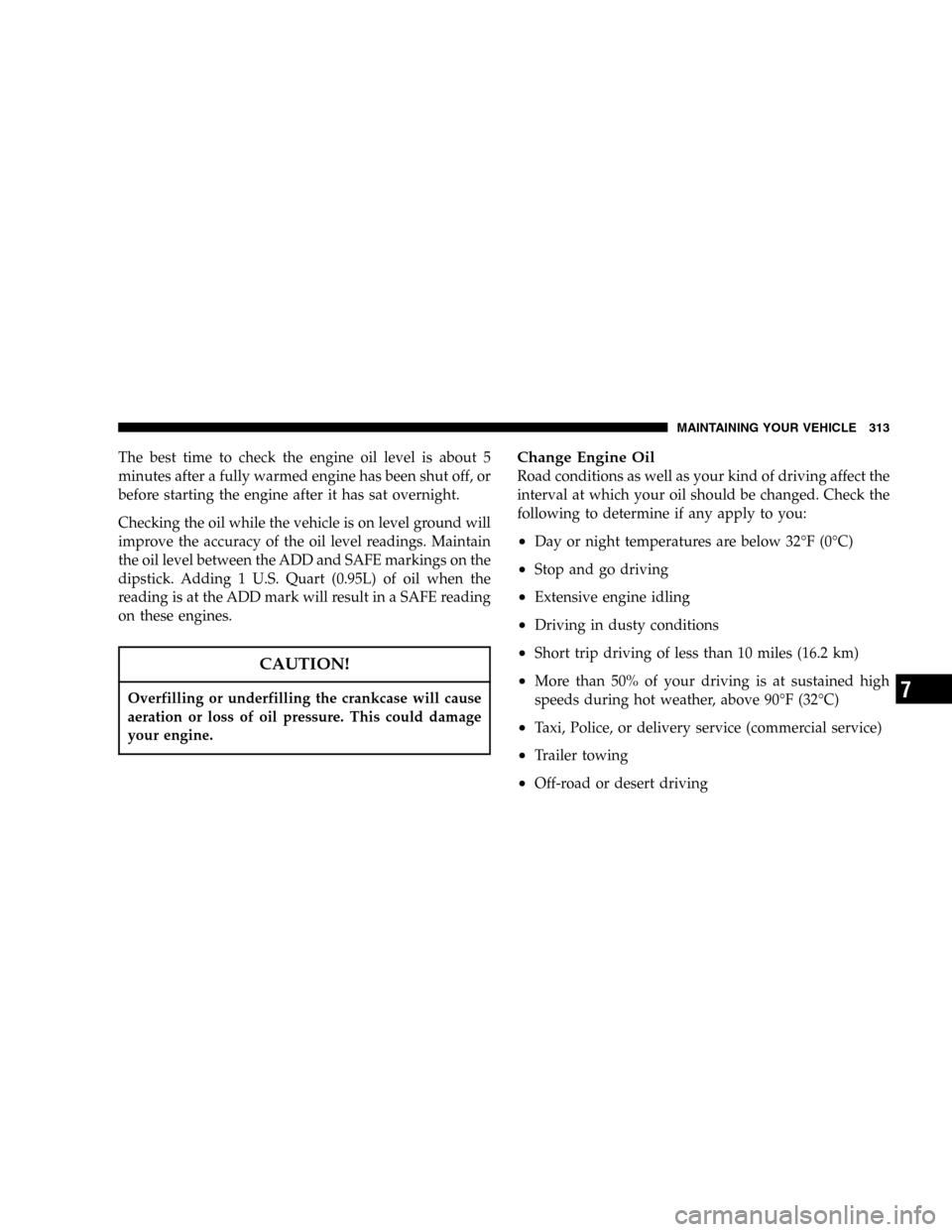
The best time to check the engine oil level is about 5
minutes after a fully warmed engine has been shut off, or
before starting the engine after it has sat overnight.
Checking the oil while the vehicle is on level ground will
improve the accuracy of the oil level readings. Maintain
the oil level between the ADD and SAFE markings on the
dipstick. Adding 1 U.S. Quart (0.95L) of oil when the
reading is at the ADD mark will result in a SAFE reading
on these engines.
CAUTION!
Overfilling or underfilling the crankcase will cause
aeration or loss of oil pressure. This could damage
your engine.
Change Engine Oil
Road conditions as well as your kind of driving affect the
interval at which your oil should be changed. Check the
following to determine if any apply to you:
•Day or night temperatures are below 32°F (0°C)
•Stop and go driving
•Extensive engine idling
•Driving in dusty conditions
•Short trip driving of less than 10 miles (16.2 km)
•More than 50% of your driving is at sustained high
speeds during hot weather, above 90°F (32°C)
•Taxi, Police, or delivery service (commercial service)
•Trailer towing
•Off-road or desert driving
MAINTAINING YOUR VEHICLE 313
7
Page 333 of 424
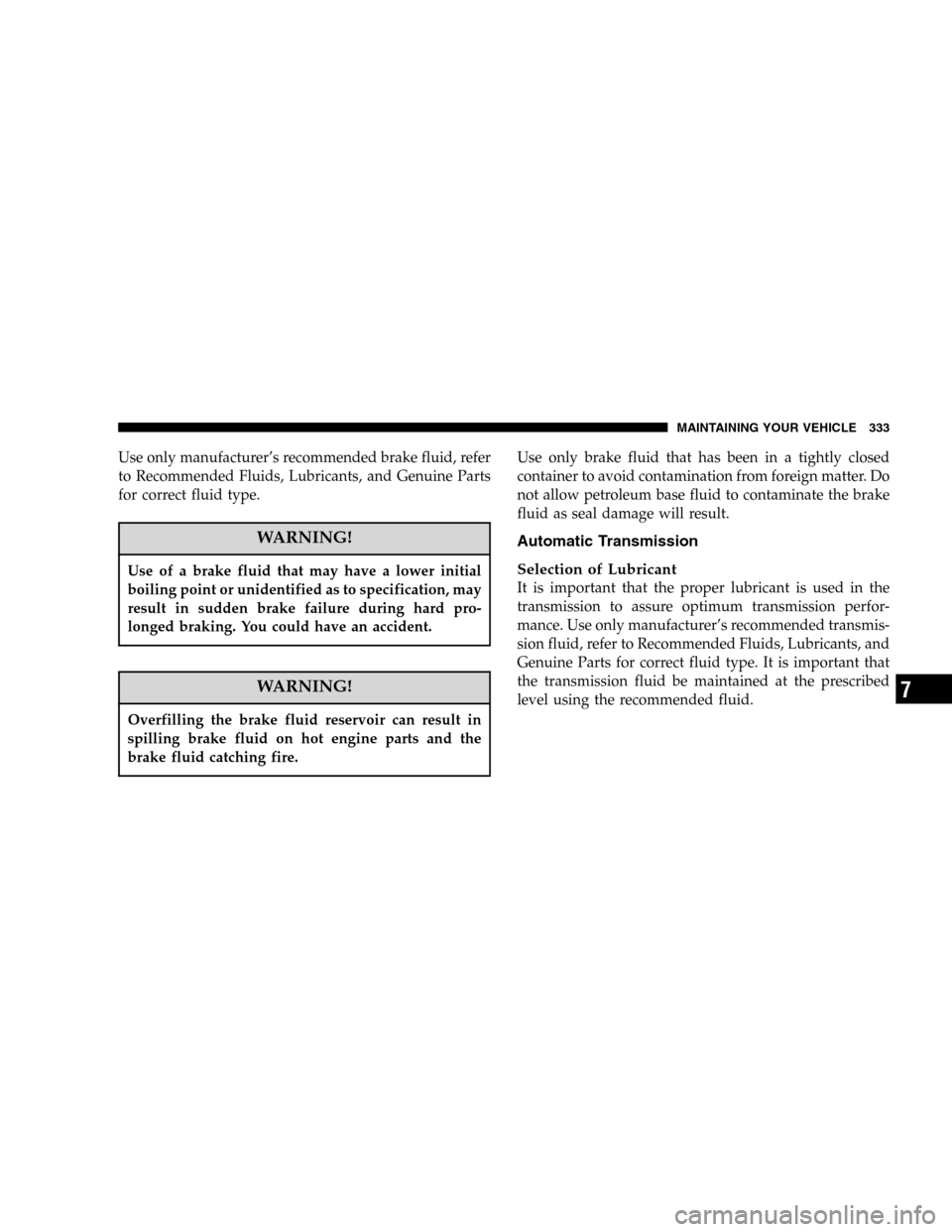
Use only manufacturer’s recommended brake fluid, refer
to Recommended Fluids, Lubricants, and Genuine Parts
for correct fluid type.
WARNING!
Use of a brake fluid that may have a lower initial
boiling point or unidentified as to specification, may
result in sudden brake failure during hard pro-
longed braking. You could have an accident.
WARNING!
Overfilling the brake fluid reservoir can result in
spilling brake fluid on hot engine parts and the
brake fluid catching fire.
Use only brake fluid that has been in a tightly closed
container to avoid contamination from foreign matter. Do
not allow petroleum base fluid to contaminate the brake
fluid as seal damage will result.
Automatic Transmission
Selection of Lubricant
It is important that the proper lubricant is used in the
transmission to assure optimum transmission perfor-
mance. Use only manufacturer’s recommended transmis-
sion fluid, refer to Recommended Fluids, Lubricants, and
Genuine Parts for correct fluid type. It is important that
the transmission fluid be maintained at the prescribed
level using the recommended fluid.
MAINTAINING YOUR VEHICLE 333
7
Page 335 of 424
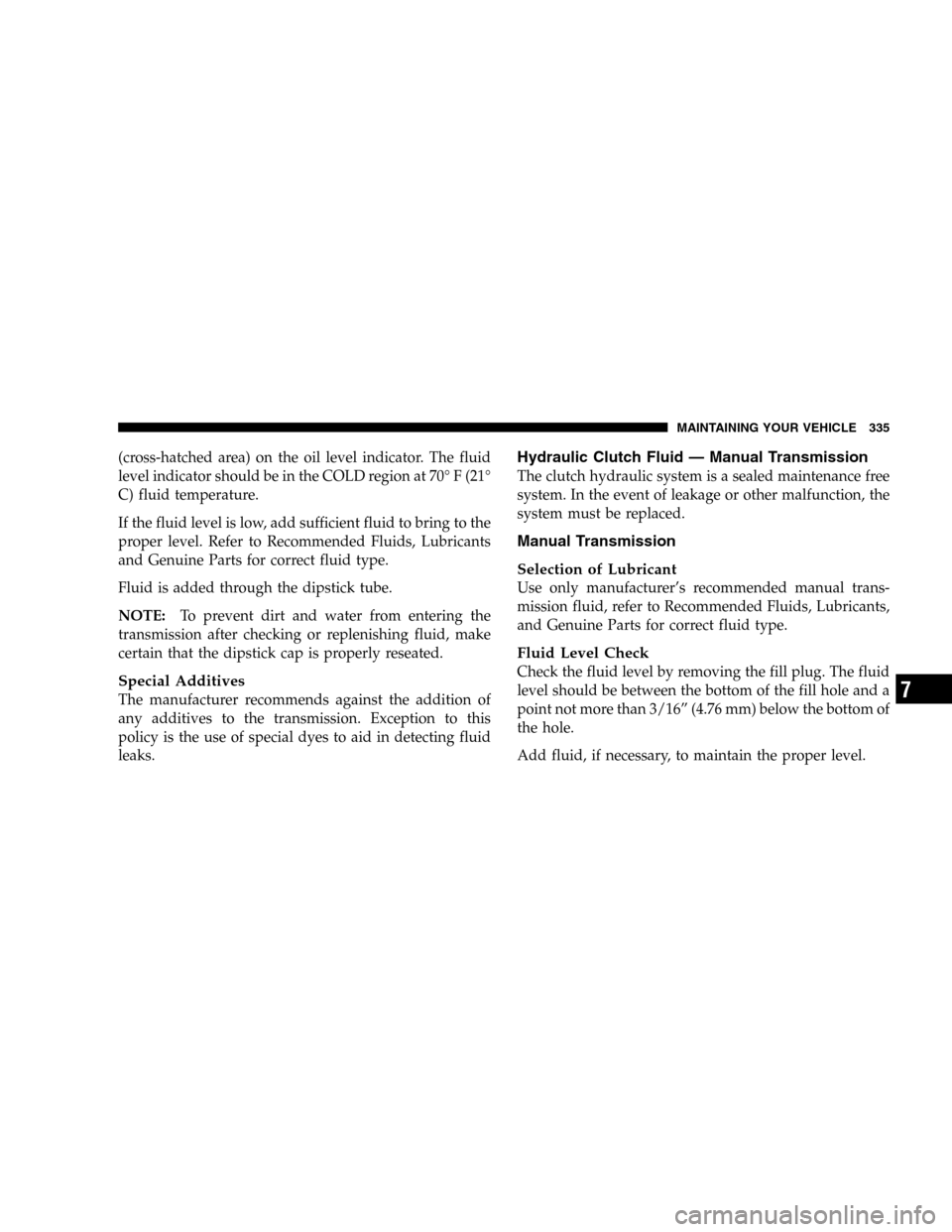
(cross-hatched area) on the oil level indicator. The fluid
level indicator should be in the COLD region at 70° F (21°
C) fluid temperature.
If the fluid level is low, add sufficient fluid to bring to the
proper level. Refer to Recommended Fluids, Lubricants
and Genuine Parts for correct fluid type.
Fluid is added through the dipstick tube.
NOTE:To prevent dirt and water from entering the
transmission after checking or replenishing fluid, make
certain that the dipstick cap is properly reseated.
Special Additives
The manufacturer recommends against the addition of
any additives to the transmission. Exception to this
policy is the use of special dyes to aid in detecting fluid
leaks.
Hydraulic Clutch Fluid — Manual Transmission
The clutch hydraulic system is a sealed maintenance free
system. In the event of leakage or other malfunction, the
system must be replaced.
Manual Transmission
Selection of Lubricant
Use only manufacturer’s recommended manual trans-
mission fluid, refer to Recommended Fluids, Lubricants,
and Genuine Parts for correct fluid type.
Fluid Level Check
Check the fluid level by removing the fill plug. The fluid
level should be between the bottom of the fill hole and a
point not more than 3/16” (4.76 mm) below the bottom of
the hole.
Add fluid, if necessary, to maintain the proper level.
MAINTAINING YOUR VEHICLE 335
7
Page 337 of 424
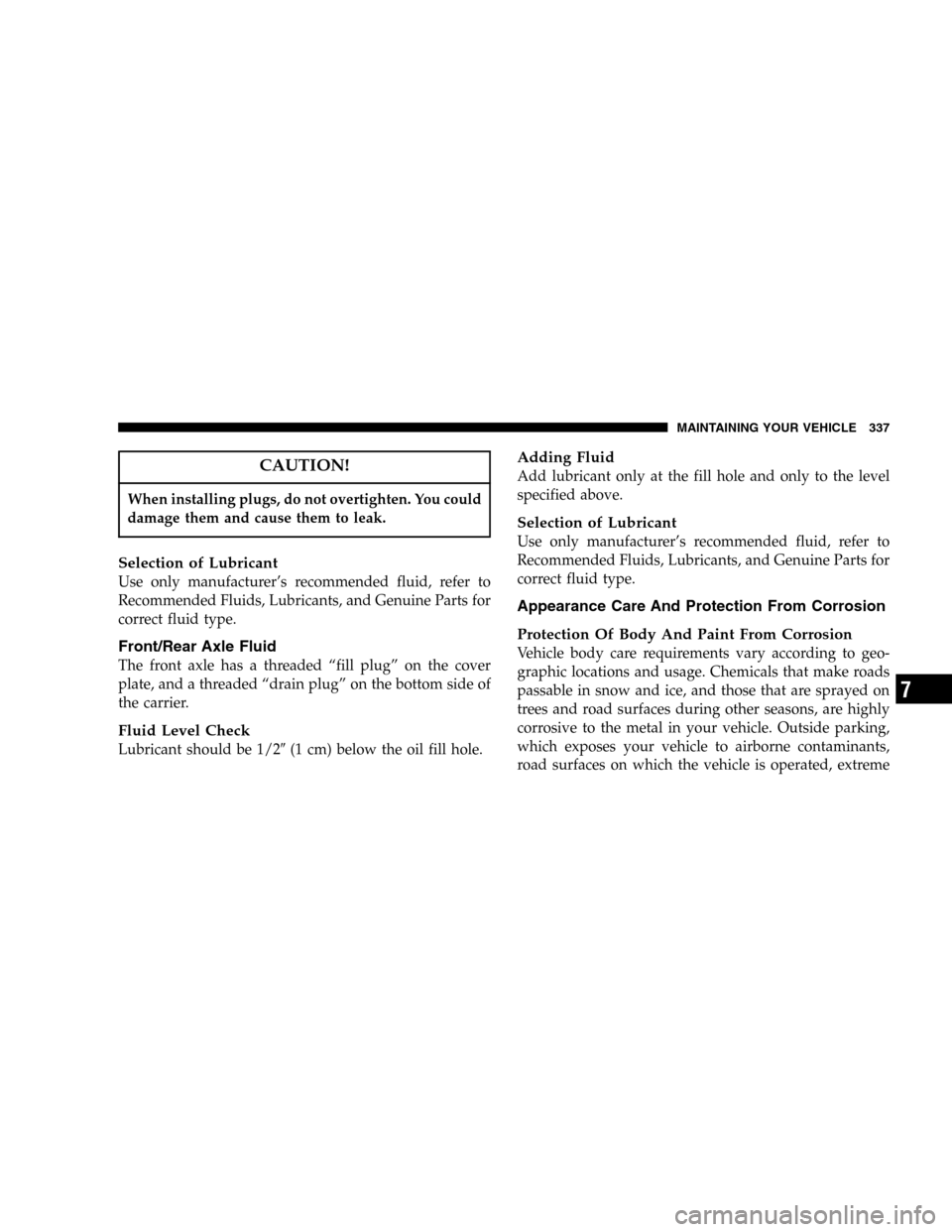
CAUTION!
When installing plugs, do not overtighten. You could
damage them and cause them to leak.
Selection of Lubricant
Use only manufacturer’s recommended fluid, refer to
Recommended Fluids, Lubricants, and Genuine Parts for
correct fluid type.
Front/Rear Axle Fluid
The front axle has a threaded “fill plug” on the cover
plate, and a threaded “drain plug” on the bottom side of
the carrier.
Fluid Level Check
Lubricant should be 1/2�(1 cm) below the oil fill hole.
Adding Fluid
Add lubricant only at the fill hole and only to the level
specified above.
Selection of Lubricant
Use only manufacturer’s recommended fluid, refer to
Recommended Fluids, Lubricants, and Genuine Parts for
correct fluid type.
Appearance Care And Protection From Corrosion
Protection Of Body And Paint From Corrosion
Vehicle body care requirements vary according to geo-
graphic locations and usage. Chemicals that make roads
passable in snow and ice, and those that are sprayed on
trees and road surfaces during other seasons, are highly
corrosive to the metal in your vehicle. Outside parking,
which exposes your vehicle to airborne contaminants,
road surfaces on which the vehicle is operated, extreme
MAINTAINING YOUR VEHICLE 337
7
Page 356 of 424
FLUID CAPACITIES
U.S. Metric
Fuel (Approximate)20.5 Gallons 78 Liters
Engine Oil with Filter
2.4/3.7 Liter Engines (SAE 5W-30, API Certified Engine Oil) 5 Qts 4.7 Liters
2.8 Liter Diesel Engine (SAE 0W-40 Mobil 1�Synthetic, API
Certified Engine Oil)6.4 Qts 6.1 Liters
Cooling System *
2.4 Liter Engine (Mopar�Antifreeze/Coolant 5 Year/100,000
Mile Formula)10 Qts 9.5 Liters
3.7 Liter Engine (Mopar�Antifreeze/Coolant 5 Year/100,000
Mile Formula)14 Qts 13.2 Liters
2.8 Liter Diesel Engine (Mopar�Antifreeze/Coolant 5 Year/
100,000 Mile Formula)11.8 Qts 12.5 Liters
* Includes heater and coolant recovery bottle filled to MAX level.
356 MAINTAINING YOUR VEHICLE
Page 362 of 424
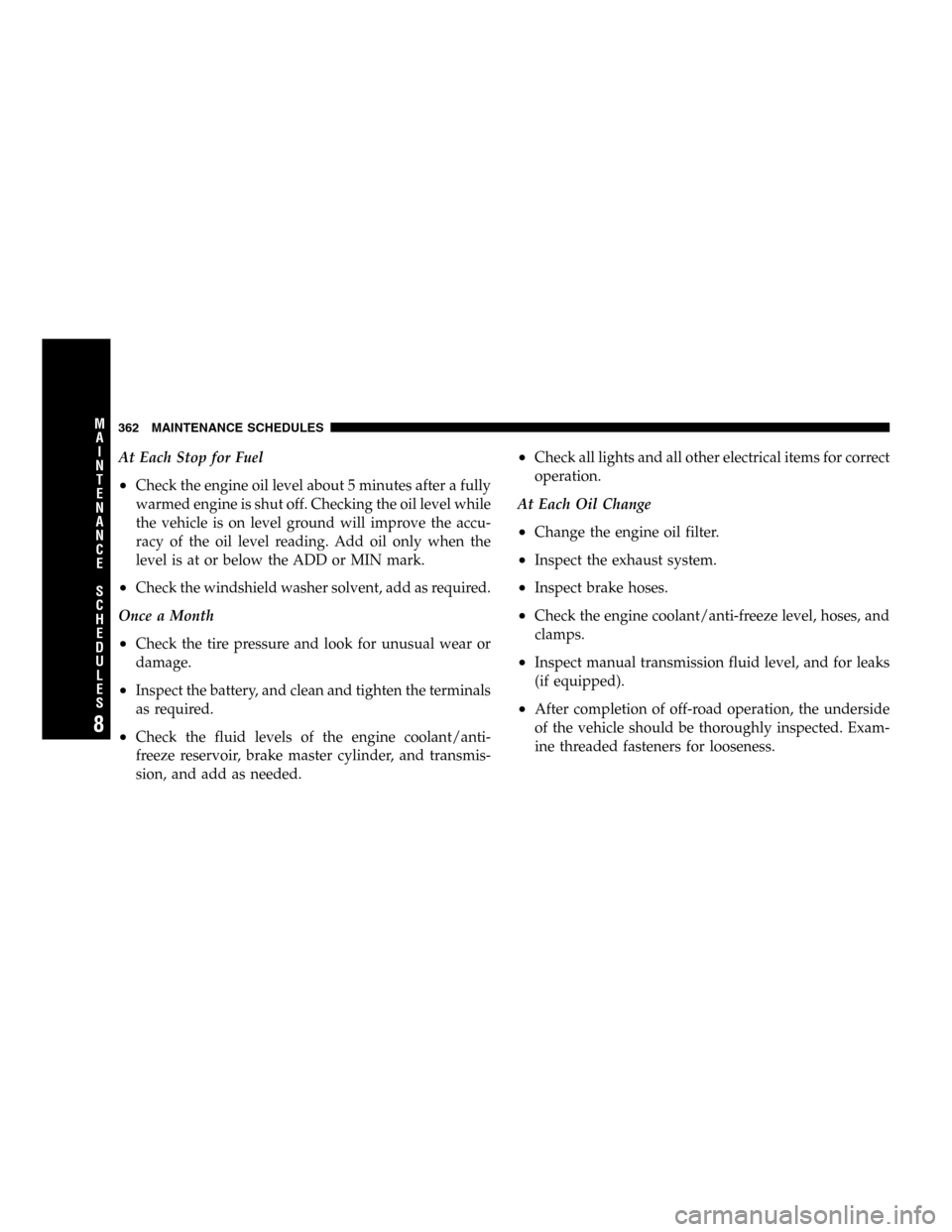
At Each Stop for Fuel
•Check the engine oil level about 5 minutes after a fully
warmed engine is shut off. Checking the oil level while
the vehicle is on level ground will improve the accu-
racy of the oil level reading. Add oil only when the
level is at or below the ADD or MIN mark.
•Check the windshield washer solvent, add as required.
Once a Month
•Check the tire pressure and look for unusual wear or
damage.
•Inspect the battery, and clean and tighten the terminals
as required.
•Check the fluid levels of the engine coolant/anti-
freeze reservoir, brake master cylinder, and transmis-
sion, and add as needed.
•Check all lights and all other electrical items for correct
operation.
At Each Oil Change
•Change the engine oil filter.
•Inspect the exhaust system.
•Inspect brake hoses.
•Check the engine coolant/anti-freeze level, hoses, and
clamps.
•Inspect manual transmission fluid level, and for leaks
(if equipped).
•After completion of off-road operation, the underside
of the vehicle should be thoroughly inspected. Exam-
ine threaded fasteners for looseness.
362 MAINTENANCE SCHEDULES
8
M
A
I
N
T
E
N
A
N
C
E
S
C
H
E
D
U
L
E
S
Page 379 of 424

At Each Stop for Fuel
•Check the engine oil level about 5 minutes after a fully
warmed engine is shut off. Checking the oil level while
the vehicle is on level ground will improve the accu-
racy of the oil level reading. Add oil only when the
level is at or below the ADD or MIN mark.
•Check the windshield washer solvent, add as required.
Once a Month
•Check the tire pressure and look for unusual wear or
damage.
•Inspect the battery, clean and tighten the terminals as
required.
•Check the fluid levels of engine coolant/anti-freeze
deaeration bottle, brake master cylinder, and transmis-
sion, and add as needed.
•Check all lights and all other electrical items for correct
operation.
At Each Oil Change
•Change the engine oil filter.
•Inspect the exhaust system.
•Inspect brake hoses.
•Check the engine coolant/anti-freeze level, hoses, and
clamps.
•Inspect engine accessory drive belts. Replace as neces-
sary.
•Inspect for the presence of water in the fuel filter/
water separator unit.
Tire Rotation
•Rotate the tires every 6,000 miles (10 000 km).
SCHEDULE “A” — GASOLINE ENGINES 379
8
M
A
I
N
T
E
N
A
N
C
E
S
C
H
E
D
U
L
E
S